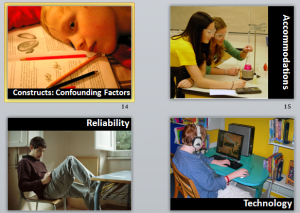Greetings this is June Gothberg, Senior Researcher at Western Michigan University. A few years ago, I became involved with AEA’s Potent Presentations Initiative and worked with Stephanie Evergreen to include universal design principles. I currently hold a position on the p2i advisory board. What I didn’t anticipate when I started working with the group is how much p2i would change my presentation worldview. At conferences or watching any presenter, I find myself reflecting on key p2i principles. I’ll say things like, “too many bullets” or “that picture doesn’t bleed off the page.” Today, I thought I’d share my own lessons learned.
Lessons Learned:
Evaluators need presentation skills. As professional evaluators we are often called upon to provide an overview of evaluation results. Our presentation skills and message can directly impact an organization’s evaluation use.
Often, you don’t know what you don’t know. I think we’ve all sat through mind numbing presentations. I’ve always blamed it on a boring speaker with poor delivery. What I didn’t know was to create potent presentations, delivery is just one component. Potent presenters need to attend to:
- Message
- Design
- Delivery
I highly recommend these two p2i tools: Presentation Assessment Rubric and The Messaging Model
If you are unsure where to begin, start with eliminating bullets. As a past classroom teacher, this was difficult for me. I thought if I didn’t put my content in bullets, the students wouldn’t learn what I intended. The problem with bulletsis your audience can read your slides faster than you can read it to them. When you use bullet points, you risk reducing your presentation to a read-aloud session (BORING!). Research shows that text heavy slides not only correlate with boring presentations, but also reduce learning. Cognitive researcher Chris Atherton found “sparse slides” increased memory and attention.
If I don’t give bullet points then how will they remember what I said?
- Find an image to represent your point.
- If you feel you must use bullets, use only one per slide. Here is an example from my own slide deck:

- Give handouts. One thing I’ve used from the field of Universal Design (UD) is the use of handouts with key points. For your audience members with visual or hearing challenges, this increases their ability to participate. It also gives your whole audience a space to take notes and follow along with key points without distracting from the presenter.
The devil is in the details and details take time. Through our work with p2i we’ve found you need to begin at least three months in advance to create potent presentations. A good planning tool with timeline for preparing presentations is the p2i Presentation Preparation Checklist.
Ensure your presentations are accessible to all. For ideas to include all people please refer to Creating Presentations Potent for All.
Rad Resources:
- AEA’s p2i website and specifically their presentation tools
- Clif Atkinson’s book Beyond Bullet Points
- Jon Thomas’ blog post What Bullet Points and Dating have in Common
Do you have questions, concerns, kudos, or content to extend this aea365 contribution? Please add them in the comments section for this post on the aea365 webpage so that we may enrich our community of practice. Would you like to submit an aea365 Tip? Please send a note of interest to aea365@eval.org . aea365 is sponsored by the American Evaluation Association and provides a Tip-a-Day by and for evaluators.

Working with stock photo sites is a good way to avoid copyright breach because they each have specific licenses that detail the proper use. You can also used the advanced search on google images and select usage rights that are free to use or share. Flickr is another good spot, where each photo has a creative commons license, which explains how it can be used and whether attribution is needed.
David,
Susan Kistler (and many others!) have blogged about some of their favorite sites for free photos. When I need high-quality graphics, I just come right here to aea365 and type “susan kistler free stock photos” into the search bar. Here are some of the search results: http://aea365.org/blog/?s=susan+kistler+free+stock+photos&submit=Go
Best of luck! Ann
(P.S. I get tons of great photos from PowerPoint directly by filtering my search results. You can just search for Illustrations (often the terribly outdated clip art), Photographs, Videos, and Audio. The Photographs option returns dozens of high-resolution images. And of course, I often make my own graphics and take my own photos.)
Thank you, sound advice and helpful links to resources.
Re using images instead of text: fine, but where and how do we find apposite images? I am heartily sick of the Windows clip art, you see the same stuff from there all the time.
What I suspect many people do is google to try and find images. Then they copy them from someone else’s website to put them to their presentation. (Disclosure: mea culpa!)
But that is a breach of copyright – we don’t want to encourage that, do we?
Regards – David